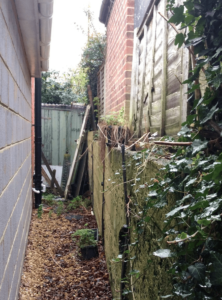Specialist Property Dispute Solicitors
What is a Party Wall?
A Party Wall is not always a boundary.
We all tend to assume that the fence or wall which surrounds our property is the boundary marker and that everything within it is ours. Unfortunately, that assumption is often wrong.
The boundaries are often physically represented by fences or walls, but the official legal boundary is marked on your title deeds, and even then it can be difficult to ascertain who actually owns the boundary marker.
Looking for legal advice on a Party Wall Boundary Disputes? Call us on FREEPHONE 0800 1404544 or one of our four local office numbers for FREE initial phone advice – no strings attached.
Our team handle Party Wall and Fence Boundary Disputes throughout both Wiltshire, Hampshire, Somerset and Dorset and nationwide from our offices in Salisbury, Fordingbridge Andover and Amesbury.
Which side of a wall or fence is my responsibility?
Normally you will be responsible for the fence on the right hand side of your property.
You may need to approach your neighbour over this. The deeds of your property will show this is the case if you need back up
The importance of title deeds
If your title deeds clearly show who owns the fence or wall on either side of the boundary, this is usually pretty conclusive way of settling any property dispute.
However, many boundaries are not clearly marked in this way in terms of ownership and disputes can easily arise as a result. One deciding factor can often be that walls tend to be far more permanent structures than fences, which can easily rot and need replacing after a few years. A wall which has been standing for many years may be seen as a far more definite boundary marker.
This is not always necessarily the case, though.
Are title deeds always correct?
It’s also important to remember that what is marked on the deeds is not necessarily gospel.
In many cases, if historical use and precedent can be proven, you might find that the ownership shown by the deeds is outdated and no longer valid. This is another reason why it is so important to establish boundaries and ownership as early as possible – so everybody is clear as to what the situation is. That way, land title disputes can be avoided before they even happen.
Are you in a dispute with your neighbour about a boundary wall or fence? Don’t leave it too long before taking advice and action
As a general rule, action will need to be taken over a boundary dispute within twelve years.
Although it’s a very complex issue, in many cases the law will call on established usage and what has been accepted to be the case historically. This is especially true when an exact boundary or ownership of a wall is not clearly shown on the Land Registry deeds or in any other documentary evidence.
The danger of “adverse possession”
Failing to act and letting a neighbour take control of a boundary wall, fence or other strip of land could result in them winning legal ownership of that land on the basis of what is known as “adverse possession”, but which is sometimes referred to as “squatting”.
Click here to read more about making or defending an adverse possession claim.
Who is responsible for maintaining a party wall?
The maintenance of walls can also easily cause disputes between homeowners, especially if there is a disagreement as to who is responsible for the upkeep of the wall.
Wall repairs can prove expensive, particularly if there’s a lot of work to be done – so establishing ownership and responsibility can be key.
Issues tend to arise when the dispute over ownership continues for a long time. Should a wall become so unstable that its condition causes injury or damage to a person or their property, the owner or personal responsible for the wall could find themselves liable for a very large legal bill, quite apart from the cost of building work.
This is just one reason why, if there’s a chance you could be responsible for a wall in a poor state of repair, establishing the facts once and for all is vital.
The Party Wall Act
In 1996, the Party Wall Act was brought in to minimise disputes.
It states that property owners must use a surveyor when carrying out work on or near a party wall. The Act is designed to protect both parties where a party wall is concerned, as well as anyone else who holds an interest in the properties.
The Act is mainly concerned with large structural changes to the party wall and its footings – so putting up shelves, carrying out of plastering work and the installation or repair of wiring and sockets, for example, aren’t affected.
The aim of the Act was to ensure that both parties were aware of imminent work and the potential adverse effects of it – with the intention of minimising disputes.
As is the ethos of the Party Wall Act, communication is key. The best way to avoid and resolve disputes is to speak reasonably to your neighbour about the issue and try to come to some sort of friendly agreement. This may not always be possible, though, particularly if your neighbour is unreasonable or feelings and tempers are running high.
What is a Party Wall Agreement?
If you plan to undertake any works that fall under the scope of the Party Wall Act 1996 you will need a Party Wall Agreement. The Agreement is a legally binding document between you and any neighbours who share a party wall, boundary, or outbuilding.
When do you need a party wall agreement?
You will need an Agreement if you plan to undertake work that:
· affects the wall shared between you and your neighbour
· affects a shared floor or ceiling
· builds on another property’s boundary
· involves excavating within six metres of a shared property
· involves repairing a party wall itself or spouts, fall pipes, sewers, drains, wire conduits, flues, chimney stacks, eaves, or troughs that are shared with a neighbouring property.
You will likely need an Agreement if you want to add on an extension or do a loft conversion.
If you are a leaseholder, you will need to notify your landlord and the freeholder of your planned works.
What is covered by a Party Wall Agreement?
A Party Wall Agreement will cover:
· The scope and method of the proposed works,
· A ‘Schedule of Condition’ which is a record (including photographs) of the condition of the adjoining properties before work starts, and
· What will be created by the works (including architectural drawings).
What are the steps to obtaining a Party Wall Agreement?
Before you embark on the formal process of obtaining an Agreement it is best to have a chat with your neighbour about the work you plan to do. If you have a good relationship your neighbour is far more likely to readily give consent.
To put an Agreement in place, you will need to give Notice including a letter detailing the work and stating:
· the date you intend to begin the works
· the names and addresses of all parties
· the date the Notice is served
All the neighbouring properties affected must receive the Notice and letter.
Except for excavations, the Notice must be served two months before the work is begun. Notice for excavations must be given one month before the start date.
If one or more of your neighbours fails to reply or refuses to consent, a dispute develops. Our Solicitors can provide expert advice on how to deal with a party wall dispute.
How Close to the Boundary can I Build?
If you want to build a wall astride the boundary line you need to obtain consent from your neighbour. As this type of work falls under the Party Wall Act 1996, you will need to serve Notice to your neighbour informing them of your plans. Again, it is always best to talk to your neighbour in person before serving Notice.
If your neighbour objects to you building astride the boundary you will have no choice but to build on your own land (inside the boundary). You will have to pay for the work; however, if your neighbour wants to use the wall, they will need to pay you compensation.
As long as your neighbour consents, you can begin building a wall on your land one month after you have served Notice. The work can also include foundations and/or footings that extend under your neighbour’s property.
Do I have to fence the boundaries of my land?
The law does not require you to fence the boundaries of your property unless your land borders:
· a railway line
· a disused mine
If you have livestock you must have adequate fencing to prevent the animals from escaping. Building sites that border a highway must also be fenced off.
Is boundary fencing affected by the Party Wall Act 1996?
Fencing in the form of timber or concrete posts and timber or wire panels is not covered by the Party Wall Act 1996. Your title may refer to a ‘party fence’ but this does not indicate the Act applies. Instead, it means that the fence is situated on the boundary and both neighbours have an obligation to maintain it.
Appointing a property dispute solicitor
If so, bringing in a solicitor with plenty of property dispute experience to review the situation is a good next step. This helps to make sure that everything is properly considered and documented before the situation gets out of hand – and that is properly aware of their legal position.
Our specialist property disputes solicitors will try to help the parties in coming to a friendly resolution which suits everybody – but sadly that is not always possible.
Your Party Wall Boundary Dispute – How we can help you
Our experienced property solicitors can advise you as to the best way to establish the ownership of and responsibility for the wall – which will help reduce the chances of extensive legal costs arising in the future.
It’s important in situations such as this to stick to the facts and try not to let emotion cloud your judgement. When a dispute happens over property and people’s homes, it’s easy to allow feelings to take over from rational though, and getting the right legal advice helps to keep the process grounded.
Your party wall boundary dispute – how mediation can help
If you can’t come to an agreed settlement, your solicitor will probably suggest mediation.
Mediation involves an independent mediator who will try to find some common ground between the two parties and help to reach an agreement between them. It is important that you do your utmost to settle the dispute at or before this stage, as the next step tends to be court – and this kind of litigation can prove very expensive, not to mention slow and stressful.
Resolving the dispute at court – the last resort
At court, the judge will want to see that you have taken all reasonable steps to avoid getting there in the first place.
You need to make it clear that an application to court was your last resort – because judges increasingly take a dim view of cases being brought in which could have been settled without the time and resources of the court being wasted.
If you are engaged in a dispute with a neighbour over a boundary wall dispute, call us today to speak to one of our expert property lawyers who will be able to advise you as to the best way to move forward and resolve your issue.
FAQs
Do I need a solicitor for party wall?
If you are in a dispute with your neighbour over a party wall, speaking to a solicitor early on can stop the situation from degenerating. People are often more open to negotiating and resolving difficulties if they know that legal action could be imminent.
If you want a party wall agreement drawn up to comply with the Party Wall Act, a property solicitor can do this for you, ensuring that it complies with the law. Should you be concerned that a neighbour is breaching your rights by building or excavating near a boundary wall, a solicitor can advise you of the best course of action.
How do you fix a party wall dispute?
The best way to deal with party wall disagreements is to speak to your neighbour and agree on a compromise if possible. If they are not carefully handled, boundary disputes can be bitterly contested and result in lengthy legal proceedings.
Involving a solicitor early on can increase the chances of finding an out-of-court solution and prevent matters from becoming more contentious. A solicitor will also be able to advise on options such as mediation and early neutral evaluation. These are alternative methods of dispute resolution that can be cheaper, quicker and less acrimonious than litigation.


